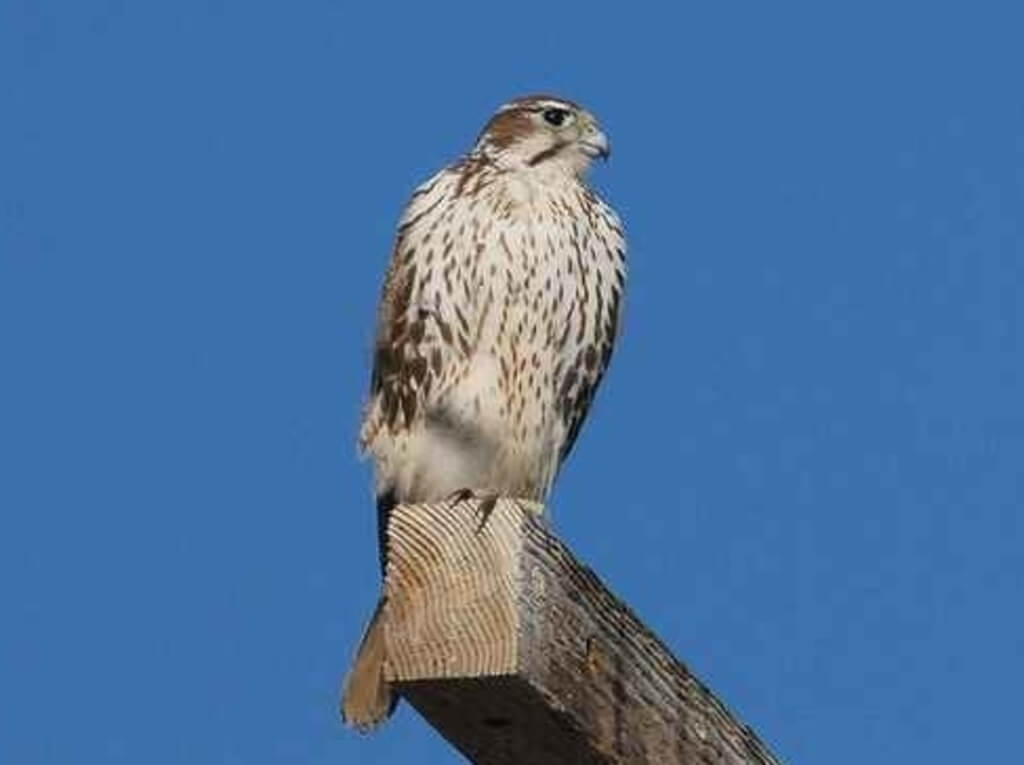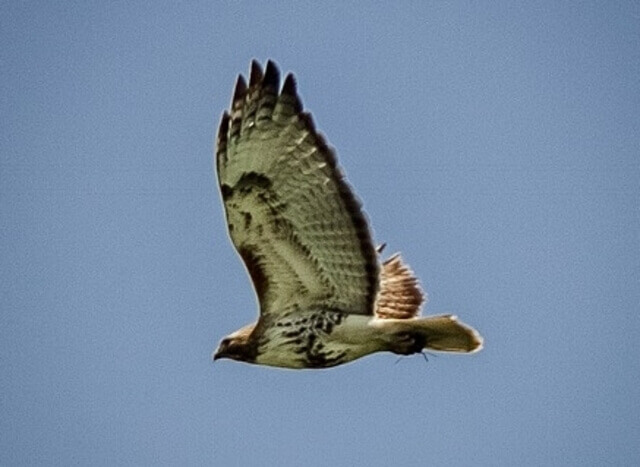Get ready to explore 60 Facts About Prairie Falcons in our journey through the captivating world of these magnificent birds of prey. From their striking appearance to their remarkable behaviors, join us as we uncover intriguing details about their habitat, hunting skills, nesting habits, and more.
Table of Contents
Prairie Falcon (Overview)
| Characteristics | Description |
|---|---|
| Identification | Orange-brown plumage above, white below with brown markings; white cheeks; thin brown mustache; yellow cere; yellow legs and feet; sharp talons. |
| Length | Males: 14.6″ – 15.0″ (37-38 cm); Females: 16.9″ – 17.7″ (43-45 cm). |
| Weight | Males: 1.1-1.4 lbs. (500-635 g); Females: 1.7-2.1 lbs. (760-970 g). |
| Wingspan | 35.8-45.3″ (91-115 cm). |
| Taxonomy | |
| Kingdom | Animalia |
| Phylum | Chordata |
| Class | Aves |
| Order | Falconiformes |
| Family | Falconidae |
| Genus | Falco |
| Species | F. Mexicanus |
| Binomial Name | Falco mexicanus |
| Scientific Name | Falco mexicanus |
| Range | Southern Canada to Northern Mexico; common in North Dakota, Montana, Texas. |
| Migration | Non-migratory, may move short distances during food shortages or breeding. |
| Habitat | Dry open country: deserts, savannas, steppes, prairies, sagebrush flatlands. |
| Diet | Ground squirrels (primary), rabbits, mice, voles, birds, insects, reptiles, amphibians, carrion. |
| Population | Over 35,000 individuals worldwide. |
| Population Pairs | Estimated 5,000 pairs. |
| Conservation Status | Least Concern (Population Increasing). |
| Lifespan | In the Wild: 15 years; In Captivity: 25 years. |
| Breeding Period | Feb – July. |
| Incubation Duration | 30 – 40 days. |
| Nesting Duration | 30 – 48 days. |
| Clutch Size | 2–5 eggs. |
| Egg Color | Cream/Ivory with brown spots. |
| Nesting Habits | Reuse nests from ravens or hawks on cliffsides and bluffs. Lay eggs on ledges. |
Prairie Falcons: Key Facts
- As a species, the Prairie Falcon was first described by Hermann Schlegel, a German ornithologist, in 1850.
- They can be found on prairies, deserts, tundra regions, and even near human habitation areas where they feast on rodents that inhabit barns and homes.
- Prairie falcons are an incredible species of bird that can see more than 8 times as far as humans. The distance they can see is up to 2 miles, which allows them to spot small animals from high in the sky.
- Prairie falcons will often build their nests on high ledges overlooking open fields, so they can spot prey quickly and easily!
- Prairie Falcons are diurnal birds because they are active during the day and rest at night. They hunt during the day to take advantage of all their senses while searching for prey.
- Prairie falcons are sexually dimorphic, with females being larger than males. Females have an average weight of about 1.7 pounds and males are around 1.1 pounds on average. Female prairie falcons will usually be heavier and have a broader wingspan than males.
- They were nearly extinct in Canada until the 1970s, when the population was dangerously low. An early ban on DDT and protection programs since then have helped increase their population in Canada and The United States.
- Prairie Falcons have been observed carrying prey as heavy as 0.8 pounds, which is about 70% of their body weight.
- The Prairie Falcon’s cruising speed is estimated at 72 km/h (44.7 mph) and they accelerate quickly during flight.
- They’re known for their high-impact dives, which can be so powerful they can literally sever the head from the body of a prey animal. It’s an odd concept to think about, but Prairie Falcons hunt by first diving into animals like ground squirrels and mice before landing on them with their feet extended forward. The force is so great it causes the spine to break, leading to instant death or paralysis for its prey.
- Prairie falcons are monogamous, staying with their partner for life. They mate for the first time when they are two years old; this is also when they choose their mate. Prairie falcons form pairs that will last for the rest of their lives and usually stay in one territory all year long. Although they will seek out a new partner if theirs leaves, dies, or becomes incapacitated in some way.
- Prairie falcon’s nesting sites are chosen 50 to 500 feet high in cliffs, but some have been found as high as 1200 feet. They will typically build their nest at the base of a cliff, and there may be up to five different nests within close-proximity of each other. Prairie Falcons use this method because it provides them with protection from ground predators such as raccoons, foxes, and coyotes.
- The prairie falcon’s territory can be as much as 400 square kilometers (154 square miles) during nesting. This means that the bird can travel far distances in search of food.
- The female prairie falcon takes on most of the nesting responsibilities, incubating the eggs and ultimately raising the chicks. Although both parents hunt for food for themselves and their offspring.
- A group of prairie falcons is called a kettle, cast, or cauldron. A group of these birds is often called a kettle because they usually fly in a circular pattern that looks like the bottom of an old-fashioned cooking pot. They are also sometimes referred to as a cast or cauldron when they form their traditional circular formation on the ground during migration season.
- Prairie Falcons are a type of bird that builds nests called “Eyries” and lays eggs in a scrape. The female falcon, creates a depression in the nest by scraping up soil with her feet. She will then use her wings to create an opening for herself to enter into the nest.
- Young prairie falcons are called “Eyas”. This term is used to distinguish them from adults. It comes from the word “Eyass” which means a young bird that has just left the nest and is learning to fly, also known as fledgling. They are still being fed by their parents until they learn how to hunt for themselves. The adult birds teach them how to catch prey in order for them to survive on their own.
- The population estimate for breeding pairs is about 5,000 throughout North America. This makes it one of the rarest birds in North America today, with only 2% of all known raptors being this species.
- A chick’s first food is usually carrion, or small prey caught by the adults, but by two weeks old they can feed on mice and other larger prey.
- They are known to attack prey while in flight or on the ground, but they are more likely to do so when in flight.
- One of the most interesting observations about the Prairie falcon’s parental care, is that the female feeds chicks after they hatch. In order to encourage them to eat, she will put food in front of them and call from outside the nest to make sure they know it’s there. The male also brings food back from his hunting trips and shares with her during feeding time.
- Protecting its territory from intruders is a critical activity for the male; its display can include spinning around or lifting its tail into a vertical position, and it may also spread its wings open and make a racking sound while circling and diving at intruders.
- The prairie falcon makes a ‘kik-kik’ call sound, which they use to communicate with other falcons. This noise is their way of talking or communicating with each other when hunting for prey or defending territory.
- The prairie falcons population has been declining for years, but scientists are now finding out that these birds have many predators. One of the main predators is the Great Horned Owl. Eagles and Gyrfalcons also prey on them, although to a lesser extent than owls do.
- The prairie falcon is a bird that can be used in falconry. Falconry is the sport of hunting small game with birds of prey, typically wild hawks or falcons. The prairie falcon is one of the most popular birds used in this hobby because it has an even temperament, and they are not as sensitive as other species such as the gyrfalcon or peregrine falcons.
- They are known for their courtship rituals, which include acrobatics and loud calls near potential nesting ledges. The male performs aerial acrobatics, struts back and forth at the nest site to lure the female in close-proximity, so she can assess his fitness as a mate. If the female approves, they may copulate.
- Prairie Falcons construct nests that blend seamlessly with the rocky cliffs they inhabit, making them nearly invisible to potential threats and human observers.
- When their nests are disturbed, Prairie Falcon parents often display a remarkable level of stoicism, with minimal outward reactions to potential threats, prioritizing the protection of their eggs or chicks above all else.
- While hunting, Prairie Falcons are known to cover extensive territories, ranging from open fields and prairies to desert landscapes, as they pursue a diverse array of prey.
- Prairie Falcons typically occupy territories with lower population densities, reflecting their preference for spacious hunting grounds and nesting sites.
- These falcons are adept at adjusting their hunting techniques based on the availability of prey, allowing them to successfully target different species and sizes of animals as circumstances demand.
Frequently Asked Questions
Do prairie falcons eat dogs?
Some people have been told that these birds will eat their dogs, but this is not true. Prairie falcons mostly eat small mammals like rodents, rabbits, ground squirrels, mice and rats which makes them great for controlling the rodent population on farms or even in your backyard
Do prairie falcons live in Texas?
Prairie falcons are found in Texas. They are not very common, but they live in the south-central region of the state. Prairie falcons nest on cliffs and feed on prairie voles, which can be seen throughout most of the US.
Do prairie falcons eat chickens?
Many people are surprised to learn that prairie falcons do in fact eat chickens. Prairie falcons, typically feed on smaller animals such as squirrels and mice. But when the population of these small animals dwindles due to a dry spell, prairies will turn their attention to livestock and poultry in order to get enough food for themselves and their chicks.
Are prairie falcons in Illinois?
The prairie falcon is a rare species in Illinois. However, sightings have been reported near the Mississippi River and Illinois River. Prairie falcons are usually only found in the western parts of North America, mostly Montana and Wyoming.
Do prairie falcons hover?
Prairie falcons are a type of bird that hover like hawks. They do not flap their wings while they hover, but instead use thermals to rise and fall in the air.
What is the top speed of the prairie falcon?
The Prairie Falcon is a fast and agile bird of prey, capable of reaching speeds of up to 55 miles per hour (88.5 kilometers per hour) during its hunting dives and flights. This impressive speed allows it to pursue and capture prey with great efficiency in its natural habitat.
What are some interesting facts about the prairie falcon?
Prairie Falcons possess remarkable vision, enabling them to spot prey from impressive distances even in challenging conditions. They are known for their aggressive defense of nests and have been observed consuming venomous snakes. Their nesting choices can be surprisingly unconventional, including power lines and urban skyscrapers. Additionally, they exhibit a unique behavior of caching food, showcasing their resourcefulness in the wild.



